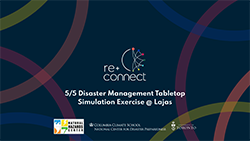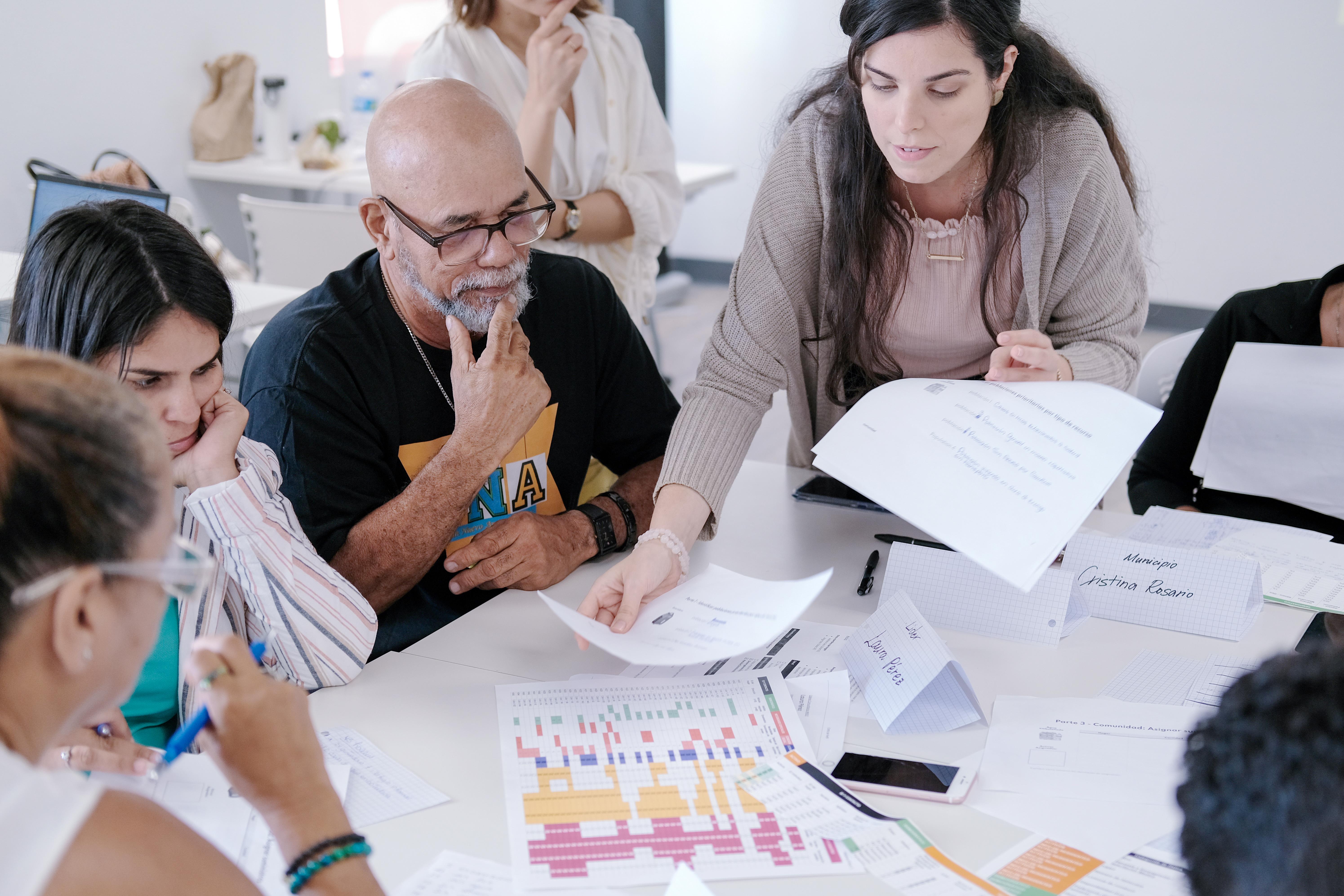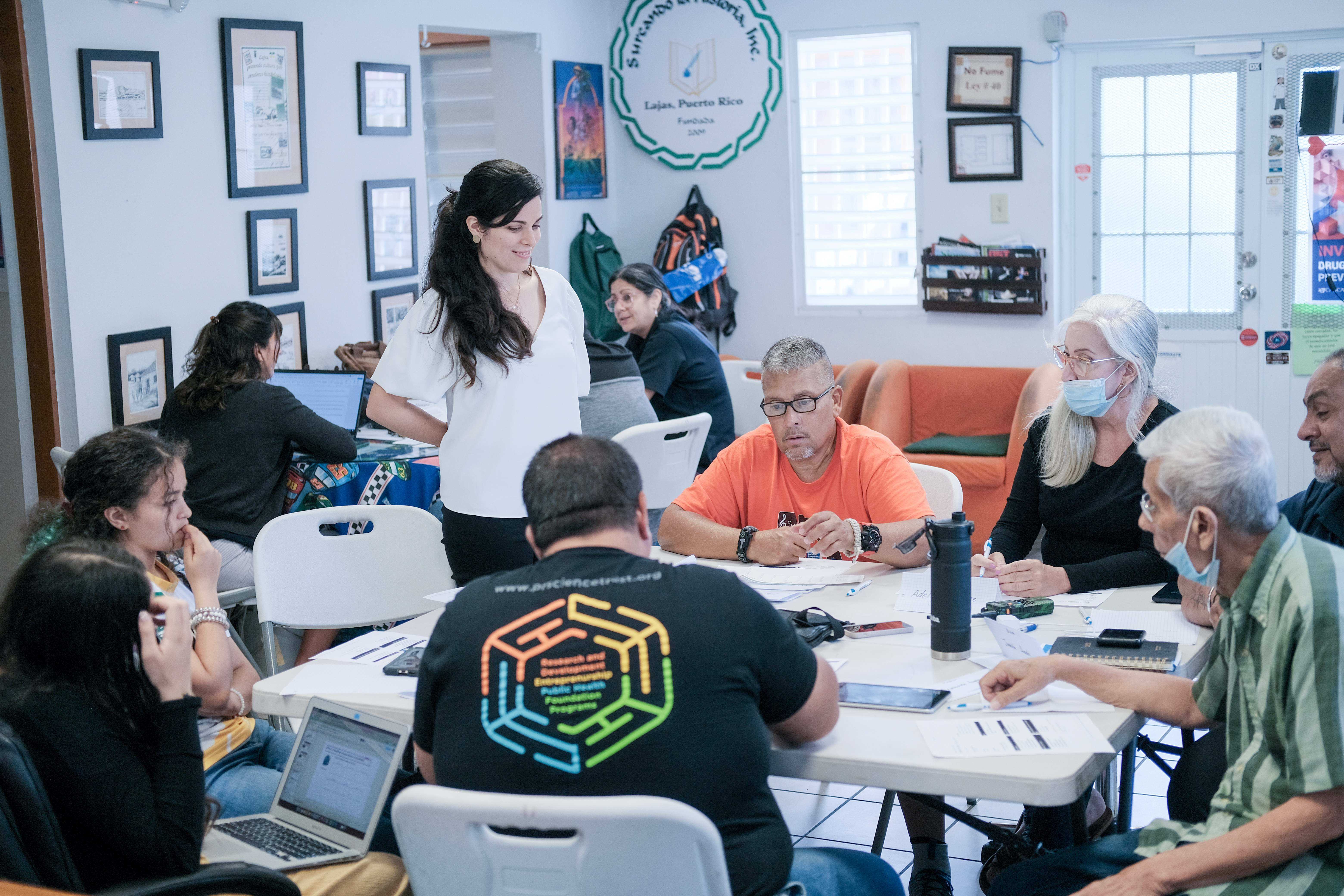Improving Disaster Information and Communication Technology Solutions In Puerto Rico
Co-Designed Community-Based Tabletop Exercises
Publication Date: 2023
Translating Research Into Action
This community-based tabletop exercise guide was developed along with residents, community organizations, and municipal representatives to test an information and communication technology-based solution to allocating resources during disasters in Puerto Rico. Click on the image below to see the guide and supporting materials.

Introduction
In the face of recent disasters, residents, community groups, and government agencies from across Puerto Rico have come together to help each other survive and recover. The communities and nonprofit sector were the first, and in many cases, the only responder. With trust and knowledge of local needs, community groups have become key actors in preparing Puerto Rico for future disasters. However, individuals and groups working outside of the official disaster management system have been largely undervalued through formal institutional structures and arrangements.
This project is part of a long-term collaborative effort to co-develop an inclusive, user-friendly digital tool—re+connect—that allows residents, community-based organizations, and humanitarian aid agencies to work together to improve mass care and sheltering during emergencies in Puerto Rico. The re+connect tool is designed to provide data-driven decision-support, coordination, and reporting functions to ensure that resources and services are delivered to the right places at the right time. View the video below to see a demonstration of how re+connect works.
Background
During our initial study—Co-Designing a Participatory Community Mapping Method for Informal Sheltering in Puerto Rico—we worked with partners in Puerto Rico in three communities affected by recent hurricanes and earthquakes to better understand the needs and resources of disaster-affected people related to sheltering. Our original project showed a strong desire from community members, the government, and community-based organizations (CBOs) to participate in a collaborative planning process. Informal shelters were seen as vital to communities and are not necessarily imagined as brick-and-mortar structures, but rather as a community hub for the sharing and delivery of resources, both material and social. We also showed that the concept of vulnerable or at-risk populations as operationalized in Puerto Rico elicits common sub-groups such as older adults, those experiencing unstable housing, and children, but appears to overlook those who are medically fragile or have access and functional needs.
 The exercise facilitator Pamela Silva Díaz explains the tasks to participants in tabletop exercise in Ponce, Puerto Rico. © Wei-Ching Azury Lin, May 4, 2023.
The exercise facilitator Pamela Silva Díaz explains the tasks to participants in tabletop exercise in Ponce, Puerto Rico. © Wei-Ching Azury Lin, May 4, 2023.
Planning for the whole individual, a concept identified as a finding from Phase 1 of this grant, led to the idea of using tabletop exercises as a tool to foster community collaboration and planning. These exercises can help gain insight into how a data-driven tool such as re+connect can be effectively utilized in low-resource settings to meet the diverse needs of a community.
Community Partners
We worked closely with three CBOs across Puerto Rico that participated in our initial Public Health Disaster Research project: Ponce Neighborhood Housing Services, Inc. in Ponce, Programa De Respuesta Episcopal a Desastres y Emergencias en la Diócesis de Puerto Rico in Loiza, and Surcando La Historia, Inc. in Lajas. These CBOs played a key role in the project as they: (a) participated in collaborative design workshops to co-create key aspects of the tabletop exercises; (b) recruited one additional community leader, five community residents, and two municipal representatives to participate in a tabletop exercise session; and (c) provided logistical support for the exercise.
Project Objectives and Activities
For this project, we used tabletop exercises to test if and how different user groups can use the tool to achieve disaster management goals. We identified three user groups and goals:
- Community residents will use the mobile application to crowdsource community information and support community disaster management activities.
- Community groups will recruit and support residents to become “community ambassadors” to crowdsource key information and coordinate with agencies to help deliver essential resources and services to the affected populations.
- Municipal disaster management agencies will utilize the software to integrate community knowledge and information into their resource and service allocation and distribution planning and coordination with local community groups.
Using disaster simulations that incorporate prototype ICT developed through prior work, this project aimed to facilitate dialogue amongst three key user groups to generate a shared understanding, build stronger relationships, and overcome barriers to inclusion and collaboration. In particular, our three objectives were:
 Tabletop exercise participants working on a task in Lajas, Puerto Rico. © Wei-Ching Azury Lin, May 5, 2023.
Tabletop exercise participants working on a task in Lajas, Puerto Rico. © Wei-Ching Azury Lin, May 5, 2023.
- Software technology—Conduct research and user testing to improve the software technology design to ensure that re+connect is reliable, user-friendly, and accessible;
- Social infrastructure—Increase understanding of how stakeholders interact during disaster relief resource allocation and distribution so re+connect can foster more inclusive collaboration; and
- Data intelligence—Explore how stakeholders use data in disaster management to make sure that re+connect leads to equitable and effective resource allocation and distribution.
With the continuation award, we collaborated with our community partners to develop, conduct, and analyze tabletop exercises in three communities: Loiza, Ponce, and Lajas. Table 1 shows the number of residents, community leaders, and municipal disaster management agency representatives that participated in the exercises. (Table A1 in the appendix provides some demographic and background information about the participants.)
Table 1. Tabletop Exercise Participants in Each Community
| Loiza | ||||
| Ponce | ||||
| Lajas | ||||
| Total |
The tabletop exercises were designed to run for three hours each. Participants were tasked with preparing and responding to a category-5 hurricane scenario. More specifically, they were asked to work together in planning the allocation and distribution of relief resources (i.e., generators, water, and disinfectant wipes) during two phases of the disaster:
- Phase 1—Before the hurricane season: Participants were asked to create a disaster preparation plan that focused on resource allocation based on the latest individual and household information.
- Phase 2—Two weeks after the hurricane’s landfall: Participants were asked to work with the municipality/community to allocate resources to meet the needs of communities/ individuals/households based on the disaster preparation plan and new information on impacts and resources.
We modified various parts of the tabletop exercise materials based on feedback and lessons learned from previous workshops. All the materials and exercise materials were conducted in Spanish and provided in paper form. All exercise materials were modeled following a modified Homeland Security Exercise and Evaluation Program approach utilizing example materials from Columbia University’s National Center for Disaster Preparedness Resilient Children/Resilient Communities Toolbox. We provide all the materials used for the tabletop exercises below.
Results
The research team worked closely with leaders from the three CBOs to collaboratively create materials for the tabletop exercise to improve the design of re+connect to support community needs and situational awareness for mass care and shelter planning and management. A list of outputs for the project is detailed in Table A2 in the appendix.
Through these tabletop exercises, the research team and participants explored key themes around how different stakeholder groups interact with each other and how they deploy data for different tasks for relief resource allocation and distribution. The themes that emerged from the exercises were:
- what are the priority populations (and the intersections of different vulnerability factors) for different resources
- how are allocation decisions made at the municipal level
- how do communities assign roles and tasks among resident community ambassadors
- how do communities allocate relief resources to households/individuals
At the end of the exercise, we asked participants to complete a post-exercise evaluation. Their responses showed that participants had overwhelmingly positive experiences during the exercise. Many participants expressed their desire to have more workshops in their communities and municipalities. They also held strong beliefs that residents, community groups, and disaster management agencies can benefit from re+connect. Tables A3, A4, and A5 in the appendix provide the full results.
Reflections and Lessons Learned
The integration of the collaborative design process and the tabletop exercises was a valuable experience for the research team, our community partners, and other participants. These experiences contributed to the collective understanding of how we can use technology, data, and social infrastructure to overcome current challenges and improve disaster relief resource allocation and distribution.
Throughout the project, several components of the process were instrumental in leading to fruitful outcomes:
- close collaboration with community partners in designing all key aspects of the exercise to make sure that the exercise was appropriate to the context, sensitive to the post-disaster conditions, and useful for community partners and participants
- pilot testing and agile iterative development process that allowed us to improve key aspects of the exercise for future workshops (i.e., group dynamics, interaction with prototypes and data, the phrasing of questions, etc.)
- long-term collaboration with our community partners since the beginning of a project to make sure that we are building something that they want and to ensure mutual trust in the process
 Tabletop exercise participants working on a task to distribute generators based on community data provided in Lajas, Puerto Rico. © Wei-Ching Azury Lin, May 5, 2023.
Tabletop exercise participants working on a task to distribute generators based on community data provided in Lajas, Puerto Rico. © Wei-Ching Azury Lin, May 5, 2023.
During the project, we also worked to resolve challenges. To start, this was the first time that some of the team members designed and conducted a tabletop exercise. To address this challenge, we worked with more experienced members to make sure that we were able to integrate the different methodologies. Second, we also worked hard to translate our digital designs into the analog (i.e., paper) form that preserves the content and most functionalities to allow participants to interact with the prototypes and evaluate the design as intended. Third, through our co-designed workshops, we worked to make sure that we were able to communicate the objectives, tasks, and prototype content (i.e., data fields) in a way the participants would be able to understand. This took time and effort, but we ultimately felt that we were able to get the message across. Finally, for these workshops, we had to adapt quickly to logistics challenges, such as the venue setup, the actual number of participants who showed up, and adjusting task lengths depending on how participants progressed.
We will also provide an after-action plan and present our findings to our community partners as indicated in Table A2. Following these exercises, we will continue to synthesize and integrate the lessons learned into the ongoing development of re+connect and explore opportunities to conduct additional workshops based on the materials we co-developed along with new iterations of the product and data prototypes with key stakeholders in Puerto Rico and other disaster-prone communities.
Community-Based Tabletop Exercise Guide and Materials
Below is the Tabletop Exercise Guide and other materials that we co-developed with our community partners and used to conduct the three tabletop exercises. This guide includes an introduction explaining the purpose and agenda for the exercise, detailed instructions leading participants through the three-part tabletop exercise, and guidance for a debrief and feedback session. The supporting materials booklet provides all handouts, information sheets, and other materials needed to conduct the exercise.
Acknowledgments. We would like to thank Reverenda Ana Rosa Mendez and Luis Daniel Oliveras from Programa De Respuesta Episcopal a Desastres y Emergencias en la Diócesis de Puerto Rico, Israel Roman from Surcando La Historia, and Jomarys Maldonado from Ponce Neighborhood Housing Services, Inc. for their participation in the development, co-design, and support in logistics during the project. We’d also like to thank the residents and municipal representatives for participating in the tabletop exercises and sharing their experiences and perspectives. The development of the ICT, re+connect, was also made possible with funding from the National Science Foundation Civic Innovation Challenge program and the Environmental Data Justice Fund.
Qin, J. Y., Lin, W. A., Díaz P. S., Arcila, N. Sury, J., & Soden, R. (2023). Improving Disaster Information and Communication Technology Solutions In Puerto Rico: Co-Designed Community-Based Tabletop Exercises. Natural Hazards Center Public Health Disaster Research Community Engagement Brief Series, 3. University of Colorado Boulder. https://hazards.colorado.edu/public-health-disaster-research/improving-disaster-information-and-communication-technology-solutions-in-puerto-rico